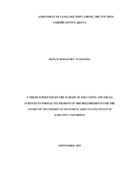| dc.description.abstract | Language shift among multilingual societies is an issue of global concern. Kenya, a multilingual society, is gradually losing her indigenous languages especially among the youth in towns and cities. The purpose of this study was to explore the extent of language shift among the youth in Nairobi County. The study was guided by the following objectives: to explore the domains in which the youth in Nairobi County use their ethnic languages; to establish the attitude the youth in Nairobi County have towards ethnic languages; to assess the influence of the gender variable on language shift among the youth in Nairobi County; and to determine the effect of ethnicity on language shift among the youth in Nairobi County. The study was based on the Domain Theory. The study employed the ex-post facto research design. The study targeted students and language teachers in public day secondary schools in Nairobi County. Simple random sampling was used to select the schools and the students to be studied. Ninety eight (98) students and seven language teachers participated in the study. Questionnaires were used as the tools of data collection. Descriptive statistics in form of frequencies, percentages, mean and standard deviation were used to analyse findings. Chi-square tests were conducted to establish the relationships between gender, attitude and ethnicity and the use of mother tongue in social and formal domains. The study found that the youth use their mother tongue sparingly and in very limited contexts such as at home or when their parents visit their schools. Students had negative attitudes towards mother tongue as they did not find it very useful. The study found that there was a significant relationship (χ2=18.143, p<0.05) between gender and the language used by students in communication with friends of the same sex. The findings also show that there was a significant relationship (χ2 =13.144, p<0.005) between gender and the language used at school. However, there was no significant relationship between ethnicity and any of the indicators of language shift. The study concludes that although majority of youth are conversant with their mother tongue, the extent to which the youth use mother tongue in social and formal domains is very low. The findings of the study would inform linguists on the current trend of indigenous languages in Kenyan urban centres and cities. The findings would also inform both the policy makers and curriculum developers on the challenges threatening the survival of the indigenous languages. | en_US |
